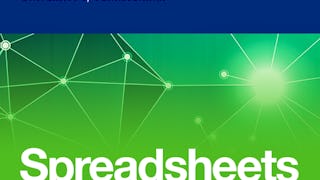How can you put data to work for you? Specifically, how can numbers in a spreadsheet tell us about present and past business activities, and how can we use them to forecast the future? The answer is in building quantitative models, and this course is designed to help you understand the fundamentals of this critical, foundational, business skill. Through a series of short lectures, demonstrations, and assignments, you’ll learn the key ideas and process of quantitative modeling so that you can begin to create your own models for your own business or enterprise. By the end of this course, you will have seen a variety of practical commonly used quantitative models as well as the building blocks that will allow you to start structuring your own models. These building blocks will be put to use in the other courses in this Specialization.

Cultivate your career with expert-led programs, job-ready certificates, and 10,000 ways to grow. All for $25/month, billed annually. Save now


Fundamentals of Quantitative Modeling
This course is part of multiple programs.

Instructor: Richard Waterman
248,185 already enrolled
Included with 
(9,106 reviews)
Skills you'll gain
Details to know

Add to your LinkedIn profile
4 assignments
See how employees at top companies are mastering in-demand skills

Build your subject-matter expertise
- Learn new concepts from industry experts
- Gain a foundational understanding of a subject or tool
- Develop job-relevant skills with hands-on projects
- Earn a shareable career certificate


Earn a career certificate
Add this credential to your LinkedIn profile, resume, or CV
Share it on social media and in your performance review

There are 4 modules in this course
In this module, you will learn how to define a model, and how models are commonly used. You’ll examine the central steps in the modeling process, the four key mathematical functions used in models, and the essential vocabulary used to describe models. By the end of this module, you’ll be able to identify the four most common types of models, and how and when they should be used. You’ll also be able to define and correctly use the key terms of modeling, giving you not only a foundation for further study, but also the ability to ask questions and participate in conversations about quantitative models.
What's included
7 videos1 reading1 assignment
This module introduces linear models, the building block for almost all modeling. Through close examination of the common uses together with examples of linear models, you’ll learn how to apply linear models, including cost functions and production functions to your business. The module also includes a presentation of growth and decay processes in discrete time, growth and decay in continuous time, together with their associated present and future value calculations. Classical optimization techniques are discussed. By the end of this module, you’ll be able to identify and understand the key structure of linear models, and suggest when and how to use them to improve outcomes for your business. You’ll also be able to perform present value calculations that are foundational to valuation metrics. In addition, you will understand how you can leverage models for your business, through the use of optimization to really fine tune and optimize your business functions.
What's included
6 videos1 reading1 assignment
This module explains probabilistic models, which are ways of capturing risk in process. You’ll need to use probabilistic models when you don’t know all of your inputs. You’ll examine how probabilistic models incorporate uncertainty, and how that uncertainty continues through to the outputs of the model. You’ll also discover how propagating uncertainty allows you to determine a range of values for forecasting. You’ll learn the most-widely used models for risk, including regression models, tree-based models, Monte Carlo simulations, and Markov chains, as well as the building blocks of these probabilistic models, such as random variables, probability distributions, Bernoulli random variables, binomial random variables, the empirical rule, and perhaps the most important of all of the statistical distributions, the normal distribution, characterized by mean and standard deviation. By the end of this module, you’ll be able to define a probabilistic model, identify and understand the most commonly used probabilistic models, know the components of those models, and determine the most useful probabilistic models for capturing and exploring risk in your own business.
What's included
12 videos1 reading1 assignment
This module explores regression models, which allow you to start with data and discover an underlying process. Regression models are the key tools in predictive analytics, and are also used when you have to incorporate uncertainty explicitly in the underlying data. You’ll learn more about what regression models are, what they can and cannot do, and the questions regression models can answer. You’ll examine correlation and linear association, methodology to fit the best line to the data, interpretation of regression coefficients, multiple regression, and logistic regression. You’ll also see how logistic regression will allow you to estimate probabilities of success. By the end of this module, you’ll be able to identify regression models and their key components, understand when they are used, and be able to interpret them so that you can discuss your model and convince others that your model makes sense, with the ultimate goal of implementation.
What's included
8 videos1 reading1 assignment
Instructor

Offered by
Recommended if you're interested in Business Essentials


University of Colorado Boulder


Rice University


University of Pennsylvania
Why people choose Coursera for their career




Learner reviews
9,106 reviews
- 5 stars
72.10%
- 4 stars
22.01%
- 3 stars
4.50%
- 2 stars
0.76%
- 1 star
0.60%
Showing 3 of 9106
Reviewed on Jul 22, 2017
Very good background to quantitative modelling. It gets a bit heavy on the mathematical formulas in places, but if you follow through, it helps cement understanding. Good speed/pace of material.
Reviewed on Jun 3, 2018
Course is having ultimate content regarding the understanding of Quantitative modeling and its applications. Having great explanation with examples of linear, power, exponential and log functions.
Reviewed on Feb 27, 2018
This is a good course for all of them who wish to work in this field and are unable to do so because of lack of core knowledge. The course helps to build this fundamental conceptual knowledge.
New to Business Essentials? Start here.

Open new doors with Coursera Plus
Unlimited access to 10,000+ world-class courses, hands-on projects, and job-ready certificate programs - all included in your subscription
Advance your career with an online degree
Earn a degree from world-class universities - 100% online
Join over 3,400 global companies that choose Coursera for Business
Upskill your employees to excel in the digital economy
Frequently asked questions
Access to lectures and assignments depends on your type of enrollment. If you take a course in audit mode, you will be able to see most course materials for free. To access graded assignments and to earn a Certificate, you will need to purchase the Certificate experience, during or after your audit. If you don't see the audit option:
The course may not offer an audit option. You can try a Free Trial instead, or apply for Financial Aid.
The course may offer 'Full Course, No Certificate' instead. This option lets you see all course materials, submit required assessments, and get a final grade. This also means that you will not be able to purchase a Certificate experience.
When you enroll in the course, you get access to all of the courses in the Specialization, and you earn a certificate when you complete the work. Your electronic Certificate will be added to your Accomplishments page - from there, you can print your Certificate or add it to your LinkedIn profile. If you only want to read and view the course content, you can audit the course for free.
If you subscribed, you get a 7-day free trial during which you can cancel at no penalty. After that, we don’t give refunds, but you can cancel your subscription at any time. See our full refund policy.
More questions
Financial aid available,



